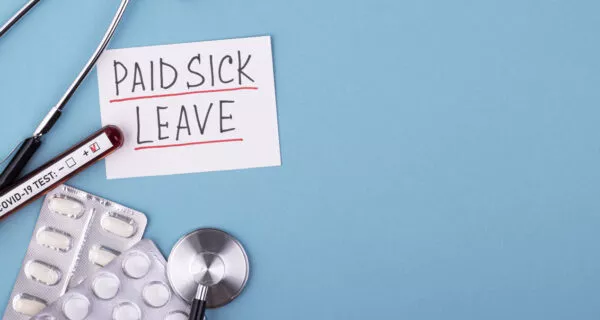Last year, California passed the COVID-19 Supplemental Paid Sick Leave law (SPSL), requiring employers with more than 25 employees to provide supplemental paid sick leave for certain absences related to COVID-19. Intended as a temporary measure, the law expired on September 30, 2021. However, given the pandemic’s continued impact, SPSL was recently revived as Senate Bill 114 and signed back into law (2022 SPSL) by Governor Gavin Newsom on February 9, 2022, with a few notable changes from last year. The 2022 SPSL goes into effect on February 19, 2022, but applies retroactively to January 1, 2022 and will remain in effect until September 30, 2022. There is no minimum period of employment required for an employee to be eligible for SPSL. The key provisions of 2022 SPSL are as follows: (a) is subject to quarantine or isolation related to COVID-19 or is caring for a family member who is in COVID-related quarantine or isolation; Family member is defined to include a child, grandchild, grandparent, parent, sibling or spouse. The quarantine or isolation period will be determined by referring to guidelines or orders issued by the CA Department of Public Health, the federal Centers for Disease Control and Prevention (CDC) or a local health officer with jurisdiction over the workplace. In the specific case of leave requested due to symptoms from a vaccine or booster, an employer may limit the leave to 3 days or 24 hours, unless the employee provides documentation from a health care provider that the employee (or their family member) is continuing to experience adverse symptoms for a longer period. Part-time covered employees are similarly entitled to one amount of SPSL for their own use, and an equal amount for family members if needed. The amount of SPSL available for part-time employees can be determined by one of several methods: Non-exempt employees (typically paid by the hour) are entitled to pay based on either the regular rate of pay for the workweek in which leave is taken or the average hourly pay for the previous 90 days (not including overtime). The total amount of pay for 2022 SPSL cannot exceed $511 per day or $5,110 total for exempt or non-exempt employees. However, an employee who has reached the maximum pay amounts may use other available paid leave to supplement his/her wages to reach 100% of normal pay. 5. Paystub Requirements The CA Labor Commissioner has issued FAQs to support employer compliance. If you have questions about the 2022 SPSL or how to comply with its provisions, please contact Christy Kotowski at [email protected] or 510-748-0930. Christy Kotowski joined Outside GC’s California team as Senior Counsel in 2019. Based in the San Francisco Bay Area, Christy handles a broad range of complex workplace issues at the federal, state and local levels. Previously, she worked as in-house employment counsel for several large companies, and started her legal career in the Silicon Valley office of Morrison & Foerster, one of California’s oldest and largest law firms. She can be reached at [email protected] or 510-748-0930.
1. Coverage and Reasons for Leave
A covered employee is someone who works for an employer with 26 or more employees AND who is unable to work/telework because the employee:
(b) has been advised by a healthcare provider to isolate or quarantine due to COVID-19;
(c) is attending an appointment for themselves or a family member to receive a vaccine or booster for protection against COVID-19;
(d) is experiencing symptoms or caring for a family member who is experiencing symptoms related to the COVID-19 vaccine or booster;
(e) is experiencing symptoms of COVID-19 and seeking a medical diagnosis; or
(f) is caring for a child whose school or place of care is closed due to COVID-19.
If an employee requests leave because they tested positive for COVID-19 or to care for a family member who tested positive for COVID-19, the employer may request documentation of the positive test.
A full-time covered employee is entitled to up to 40 hours of SPSL 2022 leave between January 1 and September 30, 2022 for their own use, and up to another 40 hours if needed to care for a family member.
4. Calculating the hourly rate for paid sick leave
Exempt salaried employees are entitled to pay for 2022 SPSL at the same rate as other forms of paid leave.
Employers are required to provide an itemized wage statement or separate written account that states how many hours of SPSL the employee has used. If the employee has not used any available SPSL hours, the employer must list zero hours used. The SPSL available must be listed separately from other paid sick days. The SPSL notice must be provided starting no later than the employer’s next full pay period after February 19, 2022 and through the pay period that includes September 30, 2022.
Covered employees who request SPSL payments retroactively to January 1, 2022 must receive those payments on or before the payday for the next full pay period after the employee makes an oral or written request for payment. The retroactive payment must be reflected in the written notice described in the preceding paragraph.
7. Notice Requirements
Employers are required to display a poster designed by the Labor Commissioner in a conspicuous place that contains information about the 2022 SPSL law. If an employer’s covered employees do not frequent a workplace, the employer may satisfy the notice requirement by disseminating notice through electronic means.
This publication should not be construed as legal advice or a legal opinion on any specific facts or circumstances not an offer to represent you. It is not intended to create, and receipt does not constitute, an attorney-client relationship. The contents are intended for general informational purposes only, and you are urged to consult your attorney concerning any particular situation and any specific legal questions you may have. Pursuant to applicable rules of professional conduct, portions of this publication may constitute Attorney Advertising.
